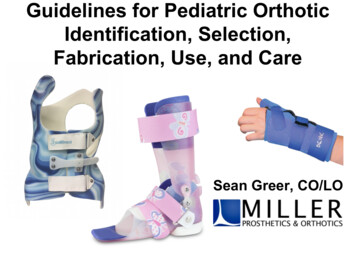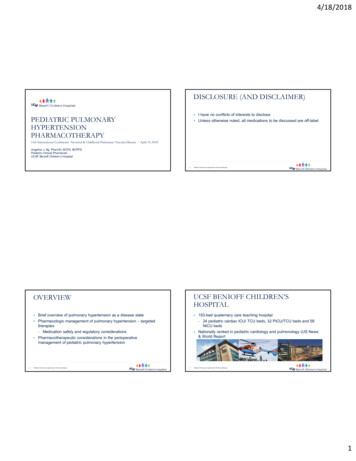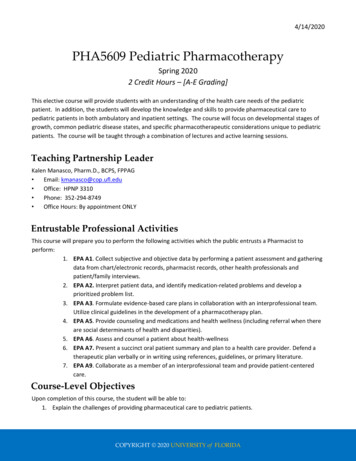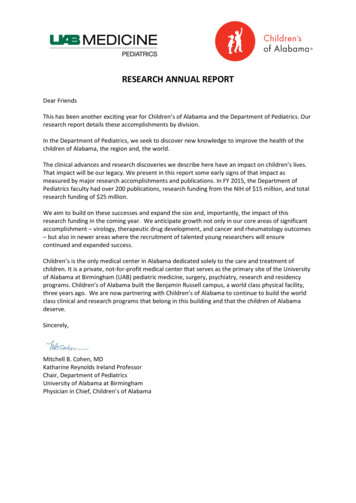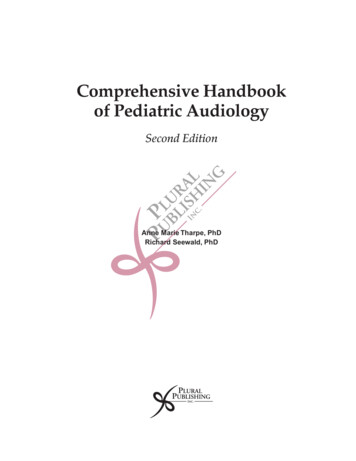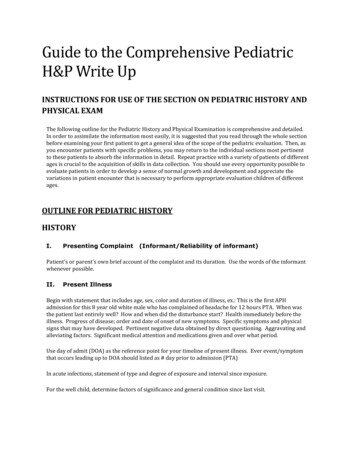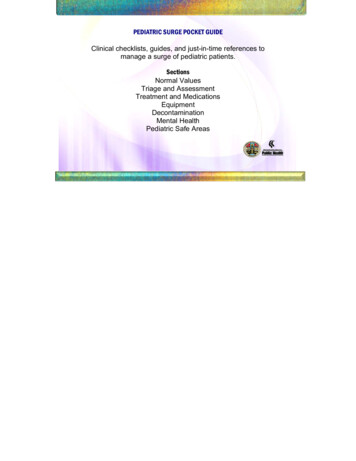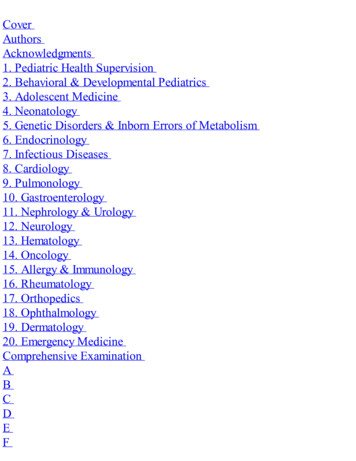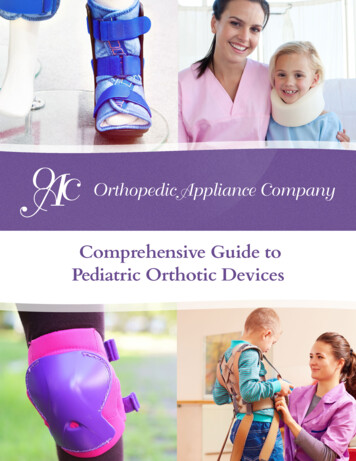
Transcription
Orthopedic Appliance CompanyComprehensive Guide toPediatric Orthotic Devices
There is no better place to live and raise a family than western NorthCarolina. Asheville and surrounding communities boast in excellent schools,quality athletic programs, and a plethora of fun activities for children. Withmild weather that is rarely extremely hot or cold, residents of mountaincommunities spend a lot of time outdoors. There are thousands of milesof hiking and mountain biking trails within a short drive from downtownAsheville. Whitewater rafting, kayaking, and tubing are popular water sportsthroughout the summer. During winter, you can find quality ski slopes in thearea as well. Whether they are playing soccer or football or exploring nature,there are plenty of reasons for children to be outside year-round.Some children require an orthotic device to control biomechanics, reducepain, rehabilitate from or prevent further injury, and improve their mobility. Ifyou are researching orthoses for your child know the importance of findingthe right device manufacturers and suppliers. For nearly sixty years, we haveworked with parents, children, and rehabilitation doctors and specialists todevelop the best orthotic devices for each child’s specific needs. In this guide,we will walk you through various orthotic devices to provide you with a betterunderstanding of orthoses and how they can improve your child’s lifestyle.We have structured this book in three parts:I.Pediatric Upper Limb OrthosesII.Pediatric Spine and Neck OrthosesIII. Pediatric Hip and Lower Limb Orthoses
Part I: Pediatric Upper Limb OrthosesObserving your child learning how to use his or her hands and arms is one of the mostrewarding and challenging parts of early parenthood. Everything is new and different andsometimes dangerous. Whether it is learning to draw and write, or reaching for somethingthey shouldn’t touch, children use their arms, hands, and fingers a lot. Meanwhile, theyare perpetually growing and changing. That is why it is critical to find the right custommanufactured upper limb orthoses provider for your child. Upper Limb Orthoses include:1. Wrist and Hand orthotic devices2. Shoulder and elbow orthotic devices3. Fracture BracingWrist and Hand Orthotic DevicesIf your child was born with a biomechanical alignment or deformity, his or her pediatricianmay recommend wrist or hand orthoses. These orthotic devices may also be used toprotect a child’s hand while he or she is recovering and rehabilitating from a wrist or handinjury. We provide three types of wrist and hand orthoses:Resting Hand Splint: This device is used to treat flexibility and mobility issues with achild’s hand, thumb, or wrist.Carpal Tunnel Brace: An uncomfortable injury for a child or adult, this device helpsCarpal Tunnel Syndrome.Thumb Spica Splint: This device is utilized to treat tendonitis, sprains, fractures, andother thumb conditions.O rt ho p e d ic Ap p lia nc e Compa nyI3
Part I: Pediatric Upper Limb OrthosesShoulder and Elbow Orthotic DevicesFrom poor posture to bicycle and playground falls to automobile accidents, sometimeschildren experience injuries or biomechanical alignment issues within their upper armsand shoulders. Shoulder and elbow orthoses help improve mobility and correct injuries tothe child’s upper arm, shoulders, collar bone, and neck.Figure 8 Clavicle Brace: These braces are used to immobilize and help a child recoverfrom injuries to the clavicle (collar bone) and issues related to poor posture.Shoulder Abduction Brace: Supporting the arm and preventing the elbow fromlowering, these devices are utilized to help a child recovering from shoulder injuries.Range of Motion Brace: A ROM brace limits motion in a child’s elbow, allowing him orher to recover from surgery, sports-related conditions like tennis elbow, and other injuries.Fracture BracingThere are a number of ways a child might fracture a wrist, arm, or elbow. From falling offthe monkey bars to soccer and basketball collisions, fracture bracing helps a child recoverfrom Injuries to the wrist and forearm.Ulnar Fracture Brace: The ulna is the bone in your child’s arm stretching from their pinkieto their elbow. Ulnar Fracture braces are rigid on the outside while providing soft tissuecompression with foam inside the brace, to prevent arm movement between a child’s wristand elbowHumeral Fracture Brace: The humerus is the bone between a child’s elbow andshoulder. In order to recover from a painful and inconvenient fracture, Humeral FractureBraces stabilize and prevent movement in your child’s upper arm.O r t h o pe di c Ap p l i a nce C o m pan yI4
Part II: Pediatric Spine and Neck OrthosesIf your child has a condition or injury that affects or restrictsthe way in which their spine moves, their pediatrician myrecommend a spinal or cervical orthotic device. Thesedevices are key to helping your child’s overall mobility. As yourchild grows, these orthotic devices will need to adapt to theirspecific needs. In this part of the guide, we will discuss a fewkey spinal and cervical orthotic devices.1.2.3.4.5.Thoracolumbosacral Orthosis (TLSO)Lumbosacral Orthosis (LSO)Cervical Thoracic Orthosis (CTO)Hyperextension OrthosisScoliosis OrthosesThoracolumbosacral Orthosis (TLSO): These devicesare typically custom-fabricated to fit your child’s specificneeds. A TLSO is a two-piece clamshell that extends from justbelow the collar bone to the pelvis. These devices are usedto immobilize the spine and decrease pain. These braces areoften worn to manage scoliosis.Lumbosacral Orthosis (LSO): Like TLSOs, LumbosacralOrthosis is used to immobilize a child’s lower spine. The braceusually starts around the xiphoid process, extending to the pelvis.Cervical Thoracic Orthosis (CTO): If your child sustains aninjury or undergoes surgery to his or her spine, a CTO may beused to stabilize and reduce the motion of their head and neck.Hyperextension Orthosis: These devices help a childimprove their spinal posture by applying three points ofpressure, preventing flexion in the lumbar and thoracic spine.Pediatric Scoliosis Orthoses: Scoliosis orthoses are plasticjackets designed to accommodate the sideways spinal curveassociated with scoliosis. Depending on the severity of thescoliosis, children may wear these devices all day, or only atnight while sleeping.O r t h o pe di c Ap p l i a nce C o m pan yI5
Part III: Hip and Lower Limb OrthosesRunning, jumping, kicking, and playing are fundamental aspects of childhood that may beaffected by injuries or biomechanical issues with a child’s hips or lower extremities. Thereare many unique orthotic devices that can help improve a child’s leg and foot mobility.If your child’s pediatrician or rehabilitation specialist has recommended one of thesedevices, we can help.Hip Abduction and Knee Ankle, and Foot Orthosis (KAFO)Hip Abduction Brace: These braces are used to stabilize the femur to the hip socket aftera dislocation, allowing a child’s hip to fully heal from injury.Femoral Fracture Brace: If your child breaks their femur, a femoral fracture brace willlikely be used to limit motion in the entire legs. These braces stabilize the femur and tibia toallow the fracture to heal.Stance Control Braces: If your child experiences quadricep weakness, multiple sclerosis,spinal cord injuries, unilateral paralysis, etc., stance control braces are used to stabilize yourknee and provide confidence when you step.Single and Double Upright KAFO: If your child requires support for multiple sclerosisor spinal cord injuries, this orthotic device spans the entire lower leg, from the foot tothe knee, providing stability for joints and support for muscles in the leg. These orthoticdevices may be used to help for anything from multiple sclerosis to spinal cord injuries.Therapeutic Ambulatory Orthotic System (TAOS): These walkers help children withneuromotor impairments such as cerebral palsy gain a measure of independence byproviding support as they stand and walk without requiring their hands to be engaged.Reciprocal Gait Orthoses (RGO): These braces aid walking by reducing hip flexion,providing support for children with spinal cord injuries, spina bifida, cerebral palsy,muscular dystrophy, or myelomeningocele.O r t h o pe di c Ap p l i a nce C o m pan yI6
Part III: Hip and Lower Limb OrthosesAnkle Foot Orthoses (AFO)Posterior Leaf Spring AFO: Used to aid withdorsiflexion during the swing of a person’s gait, PosteriorLeaf Spring AFO’s help people with conditions rangingfrom drop foot to multiple sclerosis, spinal cord injuries,and other lower extremity weakness.Metal Double Upright AFO: For children withconditions such as foot deformities or plantar ulcers,these aluminum, titanium, or stainless steels devices helpsupport the foot and provide mobility.Spiral Carbon Fiber AFO: For children with dorsiflexionweakness this orthotic device is a lightweight braceattaching to the foot and ankle, providing unobtrusivesupport.Controlled Ankle Motion Walker Boots (CAMBoots): From soccer to dance, children are often ontheir feet and susceptible to ankle injuries. These walkingboots allow children to walk without crutches whilehealing from severe ankle sprains, fractures, and tendon/ligament damage.Pressure Relief AFO: If a child is healing from plantarand heel ulcerations, a pressure relief AFO might be employed to reduce plantar flexion.Tibial Fracture Brace: For children recovering from anunfortunate tibial fracture, these braces help protect theleg and upper ankle.Dorsiflexion Assist AFO: For children with dorsiflexorweakness, this AFO helps support their feet so they canwalk more naturally.O r t h o pe di c Ap p l i a nce C o m pan yI7
Part III: Hip and Lower Limb OrthosesKnee OrthosisRange of Motion Knee Braces: As your child ages, if he or she is prone to knee injuriesor experiences a knee surgery, these braces reduce motion in the knee, allowing it to healeffectively.ACL/MCL/PCL Braces: For a child recovering from an unfortunate ACL, MCL, or PCL injury orsurgery, these braces help protect the anterior, medial, or posterior cruciate ligamentsKnee Immobilizers: To prevent unwanted movement after surgeries or knee injuries, achild might wear knee immobilizer braces to lock the knee in place while walking.Foot OrthosisCustom Semi-Rigid Functional: These devices are used to control motion in the footjoints, but since they are less rigid, they can be more comfortable and provide bettercomfort for a child.Custom Accommodative Orthoses: For children with an injury to the bottom of his orher foot, these devices are used to cushion and relieve pain from the bottom of the foot.Foot Abduction Orthosis/Denis Browne Splint: For a child who experiences clubfoot,improper foot rotation due to cerebral palsy, scissors gait, or other foot mobility issues, FAOor the Dennis Browne Splint can help adjust their gait and improve the position of the foot.Plantar Stop AFO: For a child with perpetual drop foot or dorsiflexor weakness, this bracemay be utilized to provide foot and ankle support.Supra Malleolar Orthosis (SMO): A child suffering from tibial weakness, hypotonia,chronic ankle sprains, low tone, or ankle instability may benefit from this device as itprovides foot and ankle support.O rt ho p e d ic Ap p lia nc e Compa nyI8
If you are researching orthotic devices, you probably have a lot ofquestions. Orthopedic Appliance Company is dedicated to providing thehighest quality custom orthotic devices for children and adults throughoutwestern North Carolina and the foothills. We are here to help answer yourquestions and walk with you through the process of developing the rightorthoses for your child. Furthermore, we can help ensure that your child’sdevices grow with them if necessary, providing comfort and stability foryour family. Give us a call today for more information about pediatric oradult orthoses.
1-800-972-5168 (828) 254-6305OrthopedicApplianceCo.comAsheville, North Carolina75 Victoria RoadAsheville, NC 28801Fletcher, North Carolina235 St. Johns RoadFletcher, NC 28732Hickory, North Carolina910 Tate Blvd SE Suite 103Hickory NC 28602(828) 254-6305Fax: (828) 254-61101-800-972-5168(828) 483-5781(828) 348-1960
We have structured this book in three parts: I. Pediatric Upper Limb Orthoses II. Pediatric Spine and Neck Orthoses III. Pediatric Hip and Lower Limb Orthoses. Observing your child learning how to use his or her hands and arms is one of the most rewarding and challenging parts

